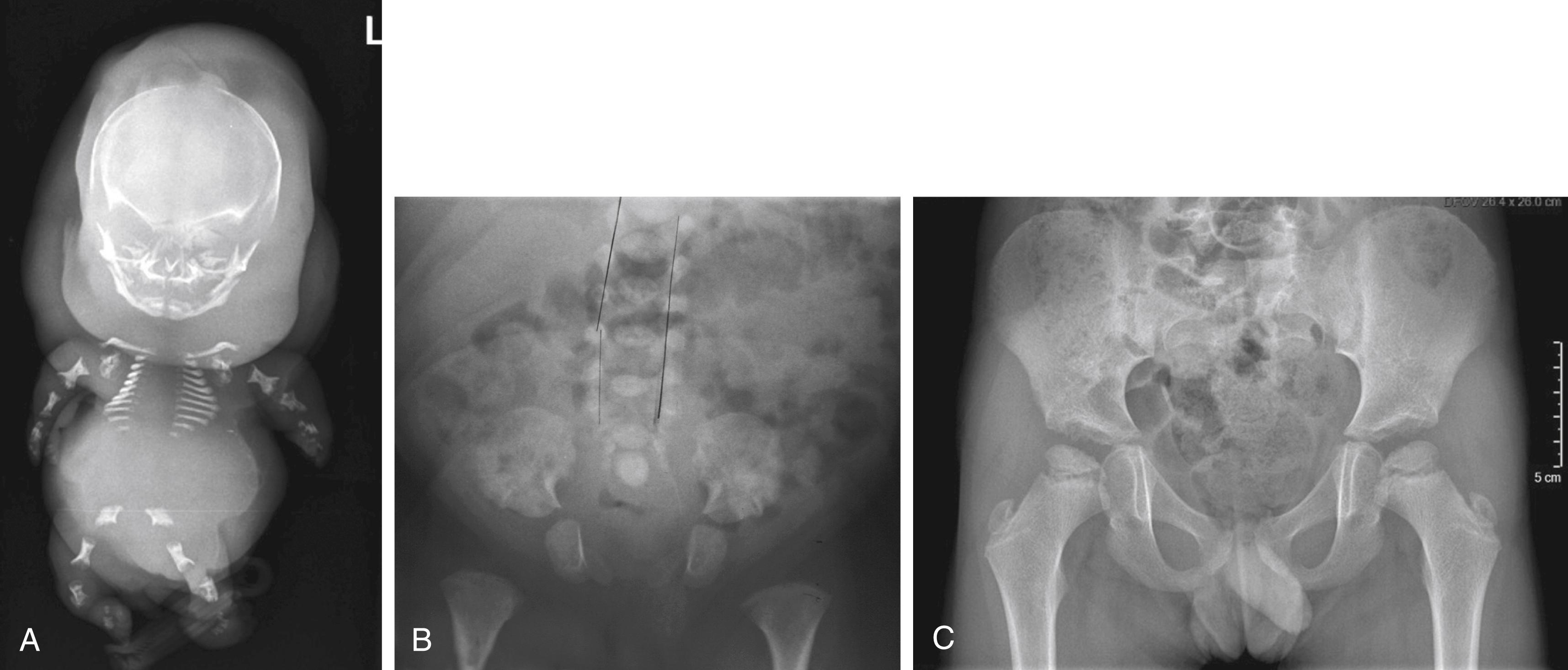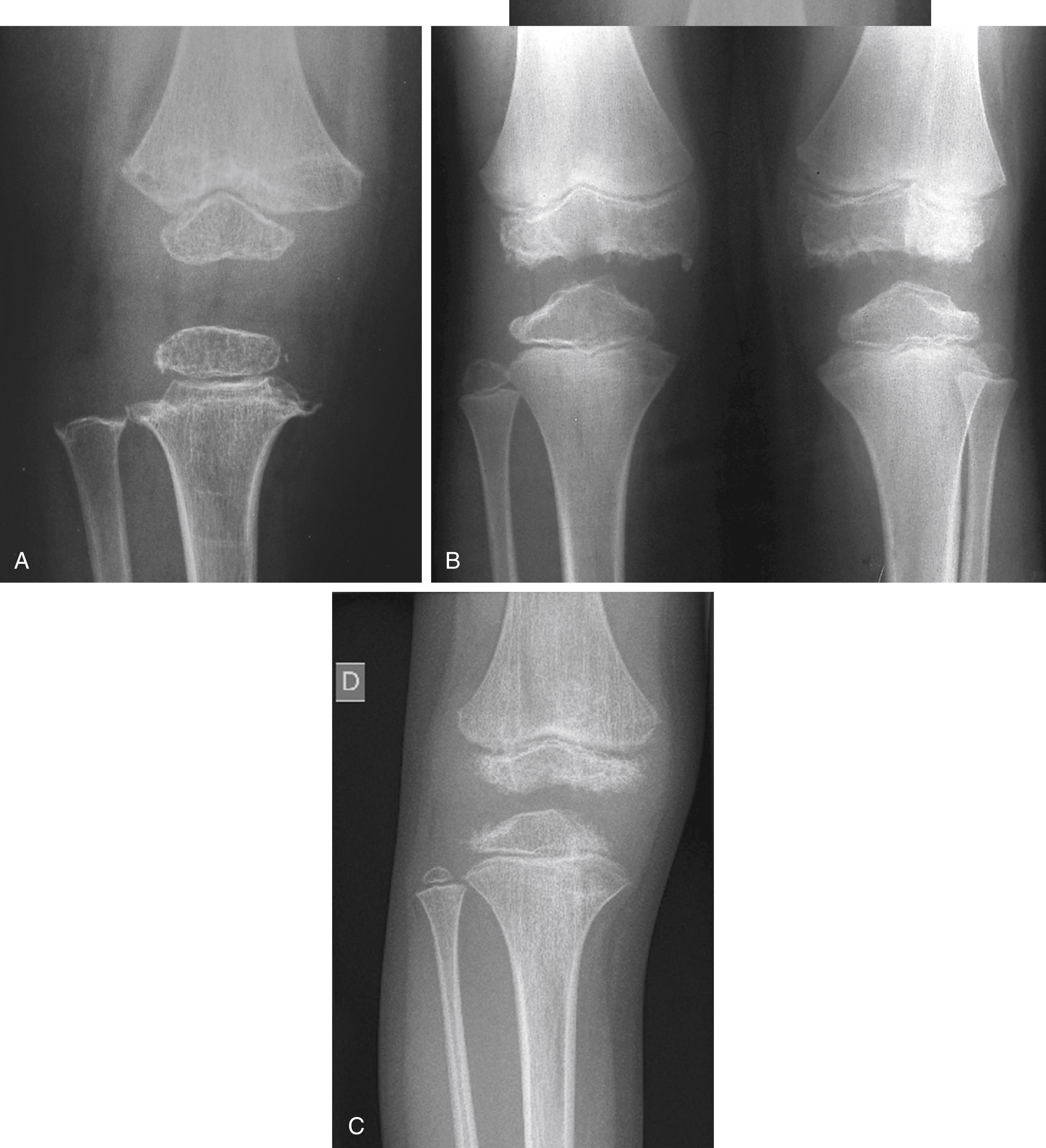Physical Address
304 North Cardinal St.
Dorchester Center, MA 02124
Skeletal dysplasias are disorders characterized by developmental abnormalities of the skeleton. They form a large heterogeneous group and range in severity from precocious osteoarthropathy to perinatal lethality. , Disproportionate short stature is the most frequent clinical complication but is not uniformly present. There are more than 400 recognized forms of skeletal dysplasia, which can make determining a specific diagnosis difficult. This process is further complicated by the rarity of the individual conditions. The establishment of a precise diagnosis is important for numerous reasons, including prediction of adult height, accurate recurrence risk, prenatal diagnosis in future pregnancies, and, most important, proper clinical management. Once a skeletal dysplasia is suspected, clinical and radiographic indicators, along with molecular tests and occasionally biochemical assays, are employed to determine the underlying diagnosis. This process starts with history gathering, including the prenatal and family history. This is followed by clinical examination with measurements and radiographs. It is important to obtain a full skeletal survey because the distribution of affected and unaffected areas is key to making a specific diagnosis.
With the development of new sequencing technologies and their rapid expansion into clinical practice, the diagnostic algorithm has changed drastically for almost all genetic conditions, including skeletal dysplasias. The speed and cost with which sequencing can be obtained has made it possible to consider such possibilities as whole exome sequencing even in the prenatal setting and has rendered obsolete the process of sequential sequencing of single genes. It is increasingly probable that patients will arrive for their consultation with their genome already sequenced, and as clinicians, we will be asked which of the identified “variants” could explain the phenotype. This chapter reviews this sequence of diagnostic steps and outlines some of the more useful radiographic findings.
Each skeletal dysplasia is rare, but collectively the birth incidence is approximately 1:5000. , The original classification of skeletal dysplasias was quite simplistic. Patients were categorized as either short trunked (Morquio syndrome) or short limbed (achondroplasia). As awareness of these conditions grew, their numbers expanded to more than 400 and this gave rise to an unwieldy and complicated nomenclature. In 1977 N. Butler made the prophetic statement that “in recent years, attempts to classify bone dysplasias have been more prolific than enduring.” The advent of molecular testing allowed the grouping of some dysplasias into families. For example, the type II collagenopathies ranging from the perinatal lethal form (achondrogenesis type II) to precocious osteoarthritis ( Fig. 49.1 ). This was followed by a period of optimism in which it seemed that the skeletal dysplasias might be easily classified into a manageable number of families. However, the volume of gene discovery in the last 10 years has shown that this was too simplistic a hypothesis. The number of genes and biological pathways involved in the pathogenesis of skeletal dysplasias is too large to accommodate a simple classification. The 2019 edition of the nosology counts 461 different conditions with 437 disease genes. One clear example of this biological diversity is osteogenesis imperfecta (OI). Originally, OI was classified into four groups based on clinical presentation, and mutations in COL1A1 and COL1A2 were subsequently found to account for a majority of cases. The most recent nosology now recognizes five clinical forms and 19 different genes (not including the genetic forms of osteoporosis that are not OI).

The nomenclature continues to undergo revisions as new molecular genetic information becomes available. The nomenclature has been renamed as a nosology to indicate that it represents a catalog of recognized skeletal dysplasias rather than a succinct grouping of the varied and numerous disorders. A framework in which to classify skeletal dysplasias on the basis of their molecular defects has been developed , that groups skeletal dysplasias by the basic function of the defective gene/gene product but does not delineate the biological pathway involved. This type of grouping is not particularly helpful in the clinic setting.
The spectrum of skeletal dysplasias ranges from perinatal lethal to individuals with normal stature and survival but early-onset osteoarthrosis. The approach to diagnosis varies between the lethal/semilethal disorders and those compatible with life; most lethal skeletal dysplasias (and many nonlethal ones) can be identified on prenatal ultrasound. An attempt should be made to make a precise diagnosis during pregnancy, but this may be impossible until after pregnancy termination or delivery. However, under experienced eyes, a prenatal ultrasound distinction can usually be made between those disorders compatible with life and those lethal prenatally or during early postnatal life. Patients with a nonlethal skeletal dysplasia generally present to their physician for evaluation of short stature. It is sometimes unclear whether the cause of growth failure is systemic or skeletal. Renal, endocrine, and cardiac abnormalities might need to be ruled out. However, these conditions present with proportionate short stature, whereas dysplasias usually cause disproportionate short stature. Also, some genetic syndromes cause significant prenatal growth failure but should be easily distinguishable on the basis of associated features, such as developmental delay and dysmorphic facies, and by radiographs. In fact, section B of Smith’s Recognizable Patterns of Human Malformation is dedicated to disorders with “very small stature, not skeletal dysplasia.” It behooves the clinician to keep an open mind to the diagnosis of short stature and consider a broad differential diagnosis.
When the clinician is presented with a child with short stature, a focused history can give invaluable clues as to the differential diagnosis. If a skeletal dysplasia diagnosis is in consideration, the history should include prenatal information and birth length. Many of the nonlethal dysplasias (e.g., achondroplasia) present with short stature at birth or a history of intrauterine growth retardation (IUGR)/short femoral length on ultrasound, whereas others (e.g., pseudoachondroplasia) present with a normal birth length with subsequent failure of linear growth. Although the age at which growth failure is first noted for a specific skeletal dysplasia is variable, it tends to be fairly constant and can be used in developing a differential diagnosis. Increasingly, both lethal and nonlethal skeletal dysplasias are being detected on prenatal ultrasound, and it is worthwhile to inquire if any ultrasounds were done during pregnancy and if any discrepancy was noted between fetal size and gestational dates.
Inquiry should be made for findings related to the skeletal system. Some of these are obvious, such as joint pain and scoliosis. Some skeletal dysplasias present with multiple congenital joint dislocations (e.g., atelosteogenesis type III or CHST3 deficiency). , Other findings that the family might notice include ligamentous laxity or conversely progressive finger contractures. Fetal joint dislocations resulting from extreme laxity can present at birth as contractures because of a failure of proper movement in utero movement. It is also important to ascertain when growth failure was first noted. Sometimes, findings unrelated to the skeletal system can be most helpful in making the diagnosis, such as abnormal hair and susceptibility to infections in cartilage-hair hypoplasia (McKusick metaphyseal dysplasia). Unfortunately, these findings are by no means constant. Parents may not consider other manifestations relevant to the diagnosis and a history will not be offered unless specifically asked for. Conversely, the diagnosis of a specific skeletal dysplasia may also lead the physician to detect abnormalities that had not been apparent to the patient or the family, such as renal abnormalities in asphyxiating thoracic dysplasia (ATD) or Jeune syndrome. Most skeletal dysplasias are associated with normal intellectual development. However, a developmental history should be taken because there are notable exceptions to this rule. For children with achondroplasia, there is a gross motor developmental delay in the first 2 years of life likely related to large head size and ligamentous laxity. Specific learning disabilities have been reported in hypochondroplasia and achondroplasia, but their significance remains controversial. Certainly, there is marked developmental delay in children with the syndrome known as severe achondroplasia with developmental delay , which is a related fibroblast growth factor receptor 3 disorder. , Dyggve–Melchior–Clausen and dysosteosclerosis are both rare dysplasias associated with severe to profound mental retardation. ,
Some children may present with joint pain and are thus directed toward a pediatric rheumatologist for that symptom prior to the recognition of their skeletal dysplasia. This is not unusual for pseudoachondroplasia, multiple epiphyseal dysplasia, progressive pseudorheumatoid dysplasia, and even mucolipidosis type 3. , In any child presenting with joint pain but lacking inflammatory signs, the clinician should consider the possibility of skeletal dysplasia even in the setting of normal stature, which may be the case in multiple epiphyseal dysplasia ( Fig. 49.2 ).

A detailed family history should also be taken. Obviously, if another family member has a skeletal dysplasia, this will be important in assessing the mode of inheritance. It is also important to note parental heights because it is possible that the child might simply have familial short stature. Frequently, there is no family history of dwarfism because many, if not most, skeletal dysplasias, including the most common (achondroplasia), are autosomal dominant but often caused by new mutations rather than heredity. Certain dysplasias are more common among certain ethnic groups, such as cartilage-hair hypoplasia in the Amish and spondyloepimetaphyseal dysplasia with joint laxity in the South African Afrikaner population.
On physical examination, various growth parameters must be precisely determined. It is important to note not only the height of the child but also the weight, head circumference, and timing of deviation from standard curve. This can sometimes establish a pattern; for example, in children with achondroplasia, the head circumference is larger than normal but the height is dramatically reduced. A simple method of determining proportions consists of measuring the lower segment (symphysis pubis to floor), subtracting this figure from the total height to determine the upper segment, and calculating the upper segment/lower segment ratio. This ratio, along with the arm span/height ratio, is used to document whether the spine or limbs are more severely shortened. When there is limb shortening, it is helpful to classify it as rhizomelic (proximal), mesomelic (middle), or acromelic (distal) depending on which segment is most affected. The term rhizomelia is frequently invoked if the clinician suspects skeletal disproportion; in many cases, it is used inaccurately. Although determining proportionality is traditionally invoked as an important principle in skeletal dysplasia diagnosis, it is rarely the key diagnostic feature.
Once a specific diagnosis has been established, it is useful to plot the child’s growth against disorder-specific growth curves. Specialized growth curves have been developed for achondroplasia, pseudoachondroplasia, spondyloepiphyseal dysplasia congenita, and diastrophic dysplasia. , These curves are most helpful for achondroplasia and should be used more cautiously for the other disorders because they show much more allelic heterogeneity and thus much greater phenotypic variability. In addition, assessment of symmetry or asymmetry can indicate certain diagnoses (e.g., Conradi–Hünermann syndrome, a form of chondrodysplasia punctata).
As in other genetic syndromes, ancillary signs can be helpful in securing the diagnosis; thus a general physical examination is also recommended. These signs include such findings as congenital heart disease, polydactyly, and dystrophic nails in chondroectodermal dysplasia (Ellis–van Creveld syndrome). A single finding is never present in 100% of patients, but if present, it can be instructive. A good example of this is the cystic ear swelling seen in children with diastrophic dysplasia, which is fairly specific for this disorder. In general, children with skeletal dysplasias do not show dysmorphic features of the head and neck, but one important feature is the Pierre Robin sequence seen in type II collagenopathies and campomelic dysplasia.
Become a Clinical Tree membership for Full access and enjoy Unlimited articles
If you are a member. Log in here